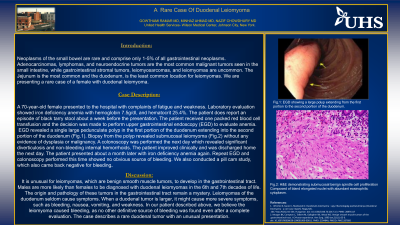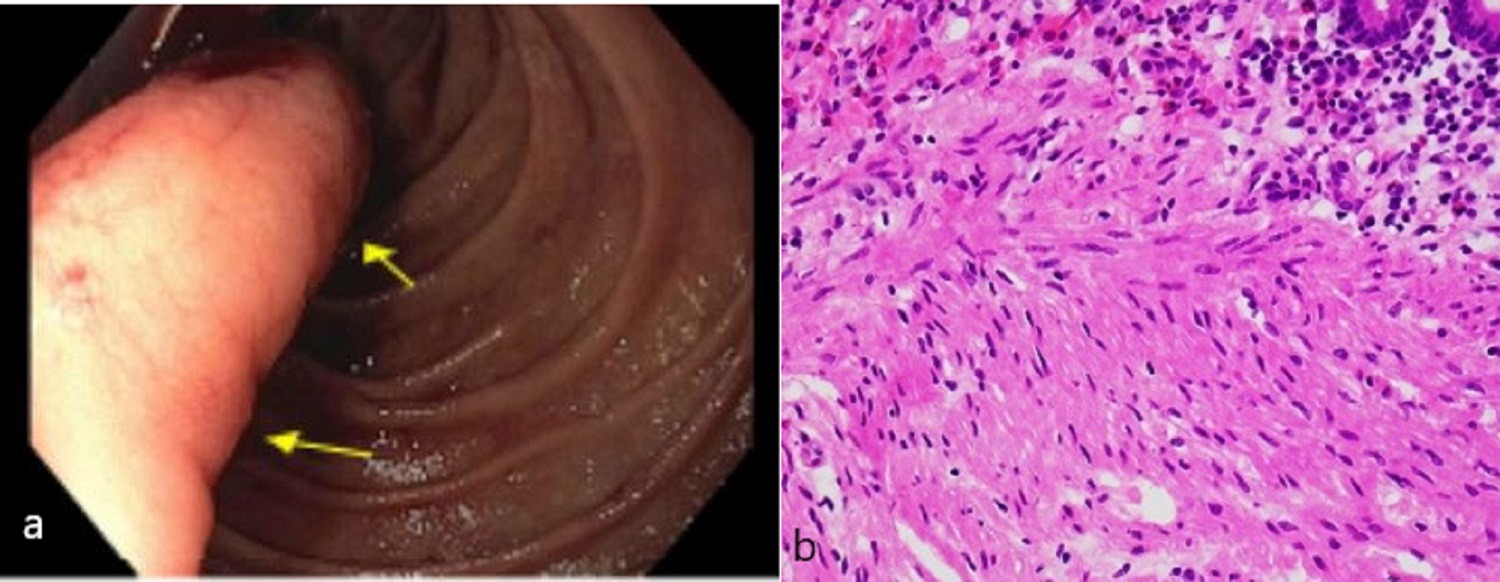Back


Poster Session D - Tuesday Morning
Category: Small Intestine
D0665 - A Rare Case of Duodenal Leiomyoma
Tuesday, October 25, 2022
10:00 AM – 12:00 PM ET
Location: Crown Ballroom

Has Audio
- GR
Gowthami Ramar, MD
United Health Services Hospital
VESTAL, NY
Presenting Author(s)
Gowthami Ramar, MD1, Minhaz Ahmad, MD2, Nazif Chowdhury, MD2
1United Health Services Hospital Wilson Medical Center, Johnson City, NY; 2United Health Services Hospital, Johnson City, NY
Introduction: Only 1–5% of gastrointestinal neoplasms are found in the small intestine. Adenocarcinomas, lymphomas, and neuroendocrine tumors are the most common malignant tumors seen in the small intestine, while gastrointestinal stromal tumors, leiomyosarcomas, and leiomyomas are uncommon. The jejunum, ileum, and duodenum are the three most common locations for leiomyomas. We are presenting a rare case of a female with duodenal leiomyoma.
Case Description/Methods: A 70-year-old female presented to the hospital with complaints of fatigue and weakness. Laboratory evaluation showed iron deficiency anemia with hemoglobin 7.5g/dl and hematocrit 25.4%. The patient reported an episode of black tarry stool about a week before the presentation. The patient received one packed red blood cell transfusion, and upper gastrointestinal endoscopy (EGD) was performed to evaluate anemia. EGD revealed non-erosive gastritis and gastric erosions without any current or recent bleeding stigmata. A single large pedunculated polyp was found in the duodenum's first portion, extending into the second portion of the duodenum(a). Biopsy from the polyp revealed submucosal leiomyoma without any evidence of dysplasia or malignancy(b). The next day, a colonoscopy showed significant diverticulosis and non-bleeding internal hemorrhoids. The patient remained hemodynamically stable and was discharged home the next day. The patient presented about a month later with iron deficiency anemia again. Repeat EGD and colonoscopy performed this time showed no obvious source of bleeding. We also conducted a pill cam study, which also came back negative.
Discussion: It is unusual for leiomyomas, which are benign smooth muscle tumors, to develop in the gastrointestinal tract. Males are more likely than females to be diagnosed with duodenal leiomyomas in the 6th and 7th decades of life. The origin and pathology of these tumors in the gastrointestinal tract remain a mystery. Leiomyomas of the duodenum seldom cause symptoms. When a duodenal tumor is larger, it might cause more severe symptoms, such as bleeding, nausea, vomiting, and weakness. In our patient described above, we believe the leiomyoma caused bleeding, as no other definitive source of bleeding was found even after a complete evaluation. The case describes a rare duodenal tumor with an unusual presentation.

Disclosures:
Gowthami Ramar, MD1, Minhaz Ahmad, MD2, Nazif Chowdhury, MD2. D0665 - A Rare Case of Duodenal Leiomyoma, ACG 2022 Annual Scientific Meeting Abstracts. Charlotte, NC: American College of Gastroenterology.
1United Health Services Hospital Wilson Medical Center, Johnson City, NY; 2United Health Services Hospital, Johnson City, NY
Introduction: Only 1–5% of gastrointestinal neoplasms are found in the small intestine. Adenocarcinomas, lymphomas, and neuroendocrine tumors are the most common malignant tumors seen in the small intestine, while gastrointestinal stromal tumors, leiomyosarcomas, and leiomyomas are uncommon. The jejunum, ileum, and duodenum are the three most common locations for leiomyomas. We are presenting a rare case of a female with duodenal leiomyoma.
Case Description/Methods: A 70-year-old female presented to the hospital with complaints of fatigue and weakness. Laboratory evaluation showed iron deficiency anemia with hemoglobin 7.5g/dl and hematocrit 25.4%. The patient reported an episode of black tarry stool about a week before the presentation. The patient received one packed red blood cell transfusion, and upper gastrointestinal endoscopy (EGD) was performed to evaluate anemia. EGD revealed non-erosive gastritis and gastric erosions without any current or recent bleeding stigmata. A single large pedunculated polyp was found in the duodenum's first portion, extending into the second portion of the duodenum(a). Biopsy from the polyp revealed submucosal leiomyoma without any evidence of dysplasia or malignancy(b). The next day, a colonoscopy showed significant diverticulosis and non-bleeding internal hemorrhoids. The patient remained hemodynamically stable and was discharged home the next day. The patient presented about a month later with iron deficiency anemia again. Repeat EGD and colonoscopy performed this time showed no obvious source of bleeding. We also conducted a pill cam study, which also came back negative.
Discussion: It is unusual for leiomyomas, which are benign smooth muscle tumors, to develop in the gastrointestinal tract. Males are more likely than females to be diagnosed with duodenal leiomyomas in the 6th and 7th decades of life. The origin and pathology of these tumors in the gastrointestinal tract remain a mystery. Leiomyomas of the duodenum seldom cause symptoms. When a duodenal tumor is larger, it might cause more severe symptoms, such as bleeding, nausea, vomiting, and weakness. In our patient described above, we believe the leiomyoma caused bleeding, as no other definitive source of bleeding was found even after a complete evaluation. The case describes a rare duodenal tumor with an unusual presentation.

Figure: a. EGD showing a large pedunculated polyp extending from the first portion to the second portion of the duodenum.
b. H&E stain showing submucosal benign spindle cell proliferation. No atypia, pleomorphism or mitotic activity
b. H&E stain showing submucosal benign spindle cell proliferation. No atypia, pleomorphism or mitotic activity
Disclosures:
Gowthami Ramar indicated no relevant financial relationships.
Minhaz Ahmad indicated no relevant financial relationships.
Nazif Chowdhury indicated no relevant financial relationships.
Gowthami Ramar, MD1, Minhaz Ahmad, MD2, Nazif Chowdhury, MD2. D0665 - A Rare Case of Duodenal Leiomyoma, ACG 2022 Annual Scientific Meeting Abstracts. Charlotte, NC: American College of Gastroenterology.
